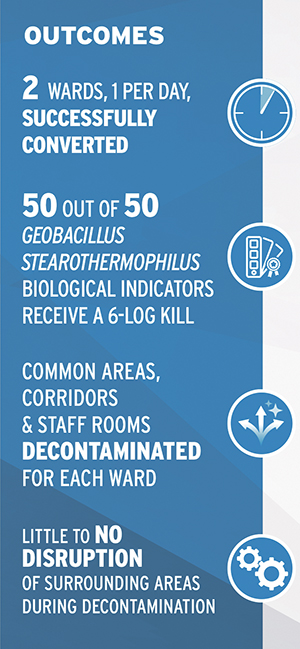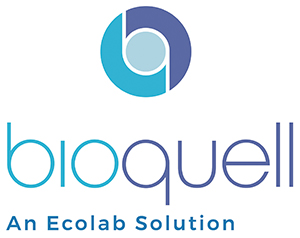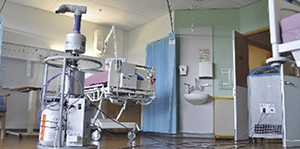Decontamination of UK hospital wards following temporary use for treatment of COVID-19 patients

 During the COVID-19 pandemic, many hospital wards were temporarily converted to solely treat COVID-19 patients. As these begin to revert back to ‘regular’ non-COVID-19 wards, a solution is required to manage the increased potential environmental contamination risk facing the patients admitted to these wards.
During the COVID-19 pandemic, many hospital wards were temporarily converted to solely treat COVID-19 patients. As these begin to revert back to ‘regular’ non-COVID-19 wards, a solution is required to manage the increased potential environmental contamination risk facing the patients admitted to these wards.
Eliminating SARS-CoV-2 from surfaces in the ward is extremely important in order to prevent further infections. With the high transmission rate of this pathogen and its ability to survive on surfaces for days [1], it is essential that any cleaning process used is able to fully eliminate surface contamination. With an efficient process the areas can be back in operation quickly whilst ensuring the safety of patients and staff.
Bioquell Rapid Bio Decontamination Service (RBDS) returning an emergency COVID-19 ward to general use
DAY 1 10:00 A vacated COVID-19 ward, including common areas, corridors, and staff rooms was readied for Bioquell.
DAY 1 14:00 The Bioquell team arrived on site to set up equipment, place Biological Indicators and Chemical Indicators (BIs/CIs) and seal vents.
DAY 1 16:00 After hospital approval, the decontamination process was initiated.
DAY 1 18:00 The ward was left sealed overnight to allow the aeration units to break down the hydrogen peroxide vapour.
 DAY 2 08:00 Bioquell engineers checked the results of the CI to verify the cycle’s efficacy and confirmed the area was safe for immediate reoccupation. The CIs showed expected efficacy of over 6-log. In 24 hours an initial report regarding the BIs was delivered, followed by a comprehensive final report after a 7 day incubation.
DAY 2 08:00 Bioquell engineers checked the results of the CI to verify the cycle’s efficacy and confirmed the area was safe for immediate reoccupation. The CIs showed expected efficacy of over 6-log. In 24 hours an initial report regarding the BIs was delivered, followed by a comprehensive final report after a 7 day incubation.
The above process was then repeated on a second ward at the same hospital.
Bioquell RBDS may be able to respond immediately in your region. Visit: www.bioquell.com for additional details.
Reference
1. N van Doremalen, et al. Aerosol and surface stability of HCoV-19 (SARS-CoV-2) compared to SARS-CoV-1.The New England Journal of Medicine. DOI: 10.1056/NEJMc2004973 (2020).

